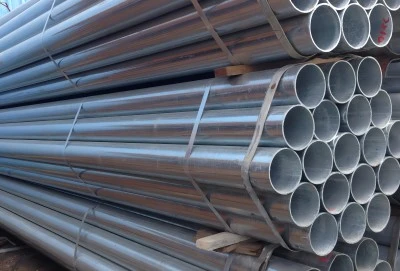When it comes to protecting steel pipes from corrosion, galvanization stands out as a crucial process. The two primary methods, hot-dip and electro-galvanization, offer distinct advantages for galvanized mild steel pipes. These techniques differ significantly in their application processes, resulting coating characteristics, and overall performance. Understanding these differences is essential for pipeline engineers, project managers, and contractors in the oil and gas, water supply, and industrial manufacturing sectors. This article delves into the nuances of both galvanization methods, helping you make informed decisions for your next project.
|
|
|
Hot-dip vs. electro-galvanization process explained
Step-by-step guide to hot-dip galvanization
Hot-dip galvanization is a time-tested method that has been protecting steel for over 150 years. The process begins with thorough cleaning of the steel pipe surface. This involves degreasing, acid pickling, and fluxing to remove all contaminants and prepare the surface for zinc adherence. Next, the cleaned pipe is immersed in a bath of molten zinc, typically maintained at a temperature around 450°C (842°F). During this immersion, a metallurgical bond forms between the steel and zinc, creating a series of zinc-iron alloy layers.
As the pipe is withdrawn from the zinc bath, excess zinc is removed through various methods such as air knives or centrifugal spinning. The result is a thick, uniform coating that solidifies quickly as it cools. This process not only coats the exterior but also the interior of the pipe, providing comprehensive protection.
Electro-galvanization: A detailed look at the process
Electro-galvanization, also known as electrogalvanizing, is a more modern approach to applying zinc coatings. The process starts with cleaning the steel pipe surface, similar to hot-dip galvanization. However, instead of immersion in molten zinc, the pipe is placed in an electrolyte solution containing zinc ions. An electric current is then passed through the solution, causing zinc ions to deposit onto the pipe's surface.
The thickness of the zinc coating in electro-galvanization is controlled by adjusting the current density and the duration of the process. This method allows for precise control over the coating thickness, which can be advantageous in certain applications. However, unlike hot-dip galvanization, the zinc coating is purely a surface layer without the formation of alloy layers.
Key differences in coating thickness and adhesion
The most significant difference between these two methods lies in the resulting coating thickness and adhesion. Hot-dip galvanized coating pipes are typically much thicker, ranging from 45 to 200 microns. This thickness provides excellent corrosion resistance and mechanical protection. The metallurgical bond formed during the hot-dip process ensures strong adhesion and durability.
In contrast, electro-galvanized coatings are generally thinner, typically ranging from 5 to 25 microns. While this thinner coating may be sufficient for some applications, it generally offers less corrosion protection compared to hot-dip galvanization. The adhesion in electro-galvanized coatings is primarily mechanical rather than metallurgical, which can impact long-term durability in harsh environments.
Durability comparison: Hot-dip vs. electro-galvanized
Corrosion resistance: Hot-dip vs. electro-galvanized pipesWhen it comes to corrosion resistance, hot-dip galvanized pipes generally outperform their electro-galvanized counterparts. The thicker zinc coating provided by hot-dip galvanization acts as a more effective barrier against corrosive elements. Moreover, the zinc-iron alloy layers formed during the hot-dip process contribute to enhanced corrosion resistance.
In contrast, electro-galvanized pipes, with their thinner zinc coating, may offer adequate protection in less aggressive environments or for indoor applications. However, they may not withstand harsh outdoor conditions or corrosive industrial settings as effectively as hot-dip galvanized pipes.
Longevity and maintenance requirements for each type
The longevity of galvanized pipes largely depends on the thickness of the zinc coating and the environment in which they are used. Hot-dip galvanized pipes typically have a longer service life, often exceeding 50 years in many applications. This extended lifespan is due to the thicker zinc coating and the presence of zinc-iron alloy layers.
Electro-galvanized pipes, while generally less durable, can still provide adequate protection in less demanding environments. However, they may require more frequent inspections and potential recoating or replacement in corrosive settings. The maintenance requirements for both types of pipes are relatively low, with periodic inspections being the primary maintenance activity.
Performance in harsh environments: Which method wins?
In harsh environments such as marine settings, chemical plants, or areas with high pollution levels, hot-dip galvanized pipes clearly outperform electro-galvanized ones. The thicker coating and metallurgical bond of hot-dip galvanization provide superior resistance to abrasion, impact, and chemical attack.
Electro-galvanized pipes may suffice in milder indoor environments or for temporary installations. However, for long-term use in demanding conditions, hot-dip galvanized pipes are the preferred choice among engineers and contractors working on large-scale projects in the oil and gas, water supply, and industrial manufacturing sectors.
Choosing between galvanization methods for pipes
Cost analysis: Hot-dip vs. electro-galvanized pipesWhen considering the cost implications of hot-dip versus electro-galvanized pipes, it's crucial to look beyond the initial price tag. While electro-galvanized pipes may have a lower upfront cost due to the less material-intensive process, hot-dip galvanized pipes often prove more economical in the long run, especially for large-scale projects or installations in corrosive environments.
The superior durability and longer service life of hot-dip galvanized pipes can result in significant savings on replacement and maintenance costs over time. For instance, in a water supply system project, the extended lifespan of hot-dip galvanized pipes could mean fewer disruptions and lower overall lifecycle costs. However, for short-term or indoor applications where corrosion is less of a concern, the lower initial cost of electro-galvanized pipes might be more attractive.
Application-specific considerations for galvanization choice
The choice between hot-dip and electro-galvanized pipes should be tailored to the specific requirements of each project. For offshore platforms or pipelines in corrosive soils, the robust protection offered by hot-dip galvanization is often indispensable. The thicker coating can withstand the harsh marine environment and resist damage from abrasive materials.
In contrast, for temporary structures or indoor industrial applications where aesthetics might be a consideration, electro-galvanized pipes could be the better option. Their smoother finish and precise coating control can be advantageous in certain manufacturing processes or architectural applications. Project managers should carefully weigh factors such as expected service life, environmental conditions, and regulatory requirements when making their selection.
Industry trends: Hot-dip vs. electro-galvanized adoption
Recent trends in the global market, particularly in regions like the Middle East, Australia, and Southeast Asia, show a growing preference for hot-dip galvanized pipes in large-scale engineering projects. This shift is driven by the increasing focus on long-term durability and lifecycle cost efficiency. Many oil and gas companies, for instance, are specifying hot-dip galvanized pipes for their offshore and onshore facilities to ensure maximum corrosion protection.
However, electro-galvanization still holds its ground in certain niche markets and applications. Some manufacturing sectors prefer the precise coating control and smooth finish of electro-galvanized pipes for specific processes. The choice often boils down to balancing immediate budget constraints with long-term performance requirements, a decision that varies across different industries and project types.
In the realm of corrosion protection for steel pipes, both hot-dip and electro-galvanization have their place. Hot-dip galvanization offers superior durability, longevity, and performance in harsh environments, making it the preferred choice for many large-scale engineering projects. Electro-galvanization, while less robust, provides a cost-effective solution for less demanding applications. Understanding these differences is crucial for making informed decisions in pipeline engineering, project procurement, and industrial manufacturing. As the industry continues to evolve, the choice between these galvanization methods will remain a key consideration in ensuring the longevity and efficiency of steel pipe installations worldwide.
China Galvanized Mild Steel Pipe Factory
Hebei Longma Group stands out as a leading manufacturer of galvanized mild steel pipes, offering top-quality products for diverse industrial applications. With advanced production equipment imported from Germany and independently developed technologies, Longma ensures superior product quality. Our professional team of over 300 employees, including 60+ technical experts, drives innovation and maintains high standards. Comprehensive testing facilities, including ultrasonic flaw detectors and X-ray equipment, guarantee product integrity. We pride ourselves on fast delivery, with standard thickness pipes ready in just 7 days. Longma holds various certifications, including API 5L, ISO 9001, and ISO 14001, assuring our commitment to quality and environmental standards. Our competitive pricing is achieved through stable raw material partnerships and efficient production processes. For high-quality galvanized steel pipes meeting API 5L, ASTM A53, EN10210, or AS/NZS 1163 standards, with diameters from 60.3-1422mm and wall thickness of 6.02-50.8mm, contact us at info@longma-group.com.














